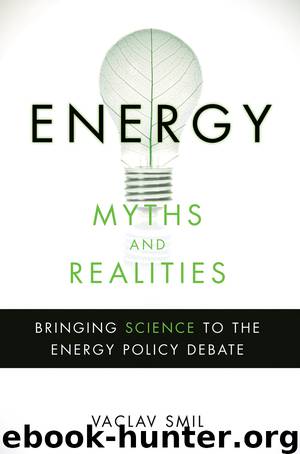Energy Myths and Realities by Vaclav Smil

Author:Vaclav Smil [SMIL, VACLAV]
Language: eng
Format: epub, mobi, pdf
ISBN: 978-0-8447-4328-8
Publisher: Rowman & Littlefield Publishing Group, Inc.
6
Liquid Fuels from Plants
There is nothing new about liquid biofuels for transportation.1 Henry Ford, for example, was a great promoter of ethanol, and his famous Model T could run on gasoline, ethanol, or a mixture of the two fuels, much like today’s touted Brazilian flex vehicles. Increased fuel demand during World War I boosted U.S. ethanol production, but the introduction of leaded gasoline and the increasingly inexpensive refining of crude oil left hardly any economic room for crop-derived ethanol.2 This situation began to change only after OPEC’s two rounds of large oil price increases in 1973–74 and 1979–81. Brazil’s was the first serious entry into this new energy industry. The country’s sugar cane–based National Alcohol Program (Proálcool) began in 1975, and eventually more than half of Brazilian cars were using anhydrous ethanol.
By contrast, U.S. activities remained slow moving and marginal in their overall impact. Commercial production of fuel ethanol began in 1980, and it took nearly fifteen years to surpass 5 billion liters; accelerated expansion began only in 2002; more than 15 billion liters were shipped in 2005, 25 billion liters in 2007 (see figure 6-1) and 35 billion liters (9 billion gallons) in 2008. Much higher targets lie ahead: In June 2007 the Senate passed an energy bill that mandated no less than 36 billion gallons of ethanol by the year 2022, a very impressive seventeenfold expansion of ethanol output in two decades. But even if gasoline consumption continued to grow no faster than it has since the year 2000, it would reach about 180 billion gallons by 2022.
Because the energy content of ethanol is only 65 percent that of gasoline, 36 billion gallons of ethanol would be equal to no more than about 13 percent of the likely 2022 gasoline demand. Clearly, this is not the way to emasculate OPEC. And even with the 2022 gasoline demand cut to half the expected level thanks to new (and, for America, rather draconian) fuel efficiency requirements, and with the ethanol production mandate fully met, the share would rise to no more than a quarter of the total—again, no way to achieve the ever-elusive energy independence. But ethanol advocates ignore such likelihoods as they point out the fuel’s environmental and security benefits.
Download
Energy Myths and Realities by Vaclav Smil.mobi
Energy Myths and Realities by Vaclav Smil.pdf
This site does not store any files on its server. We only index and link to content provided by other sites. Please contact the content providers to delete copyright contents if any and email us, we'll remove relevant links or contents immediately.
The Secret History by Donna Tartt(16606)
The Social Justice Warrior Handbook by Lisa De Pasquale(11485)
Thirteen Reasons Why by Jay Asher(7779)
This Is How You Lose Her by Junot Diaz(5753)
Weapons of Math Destruction by Cathy O'Neil(5027)
Zero to One by Peter Thiel(4816)
The Myth of the Strong Leader by Archie Brown(4785)
Promise Me, Dad by Joe Biden(4439)
Stone's Rules by Roger Stone(4412)
Beartown by Fredrik Backman(4401)
How Democracies Die by Steven Levitsky & Daniel Ziblatt(4392)
The Fire Next Time by James Baldwin(4336)
100 Deadly Skills by Clint Emerson(4070)
A Higher Loyalty: Truth, Lies, and Leadership by James Comey(4024)
Rise and Kill First by Ronen Bergman(4008)
The David Icke Guide to the Global Conspiracy (and how to end it) by David Icke(3875)
The Farm by Tom Rob Smith(3869)
Secrecy World by Jake Bernstein(3773)
The Doomsday Machine by Daniel Ellsberg(3725)
